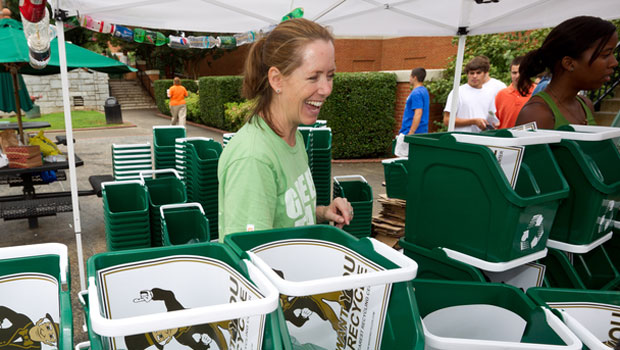
Forty years after Earth Day was first celebrated in 1970, simple strategies to combine sustainable principles and everyday decision-making can remain elusive.
“Sustainable living is not a one-size-fits-all set of items on a list that can be marked as ‘done,’ which can be challenging in a checklist society,” says Wake Forest’s sustainability director Dedee DeLongpré Johnston. “To really make a difference, we need the right tools to think through the hard questions.”
When deciding whether or not to make a purchase, for example, DeLongpré Johnston suggests looking at the life cycle of the product:
• Where, with what materials and under what conditions is the product made? How much water and energy were used? How much waste was produced? Is the manufacturer committed to safe labor conditions and fair wages?
• How does the product perform? Is it durable? Does is require a lot replacement components?
• Is the product recyclable? Will the company take back the item at the end of its life and reuse or recycle its components?
• Most importantly, do I even need it?
We don’t promote the “gospel according to green,” DeLongpré Johnston says, and she encourages a healthy dose of skepticism in students when it comes to eco-friendly claims. “If something sounds too good to be true, it likely is. There is often a lot of ‘greenwashing’ in claims like ‘earth-friendly,’ ‘organic’ and ‘eco-safe.’ There are many ‘all natural’ products that we would not want to put into or on our bodies.” Students are encouraged to learn more about third-party certification marks and how to research a company’s sustainability claims.
In exploring whether a product or behavior is sustainable, students active with the Office of Sustainability learn that there are no easy answers and that choices may involve tradeoffs. When selecting the t-shirts given away as part of the 13 Days of Celebrating the Earth event series, a choice had to be made between buying regionally-produced shirts made from locally-grown cotton and the same shirts made from certified organic cotton grown in Pakistan. “Though there are additional impacts associated with transporting cotton from Pakistan, choosing this option over the other would be an opportunity for us to support an economically viable alternative to growing poppies for opium—a lucrative activity that supports many families in Pakistan. Every dollar spent is a vote in support of a set of outcomes,” adds DeLongpré Johnston. “We make a value judgment with every purchase.”
Though the challenges of caring for and repairing the world can seem overwhelming, DeLongpré Johnston celebrates with students when they take a first step, no matter how small, toward sustainable living. “When a student makes the decision to try a new behavior to reduce his or her environmental impact, and that decision is celebrated by his or her peers, it is often the beginning of a lifelong interest in sustainability,” she says. “If students are only left to ponder the gloom and doom of it all, they lose their inspiration to think creatively about solutions. We all have to have a sense that it’s possible to turn things around.”
“Try-on” Ideas
“Try-on” ideas encourage people to plug in to sustainability in a personal way, says DeLongpré Johnston. “These suggestions are doable activities that can help people feel successful at making a difference rather than overwhelmed by the challenges. Sustainable living starts with the first step.”
• Try timing a 5-minute shower, and turn off the water when brushing your teeth or shaving.
• Try using a carbon footprint calculator to learn more about how much energy you use (directly and indirectly). Choose one wasteful habit and commit to changing it.
• Try reducing waste with every purchasing decision. Before buying anything new, consider how durable the item is, how quickly it will wear out and become trash, how much it will take to maintain it, and whether or not it can be recycled or sent back to the manufacturer at the end of its useful life.
• Try focusing on values other than price when making purchasing decisions. “When we buy that $1.99 shirt, we often have to give up something else that’s important to us, because the true costs of the clothing have been externalized onto the environment and the backs of the people making the clothes,” says DeLongpré Johnston.
• Try learning more about sustainability by watching documentaries, reading the news, and taking local action in an area about which you feel passionately.
Categories: For Alumni, For Parents, Life on Campus, Sustainability, Top Stories
Headlines
Wake Forest in the News
Wake Forest regularly appears in media outlets around the world.




